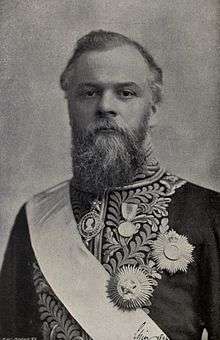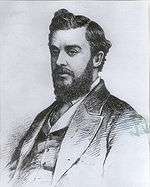Victor Bruce, 9th Earl of Elgin
| The Right Honourable The Earl of Elgin KG GCSI GCIE PC | |
|---|---|
 | |
| Secretary of State for the Colonies | |
|
In office 10 December 1905 – 12 April 1908 | |
| Monarch | Edward VII |
| Prime Minister | Henry Campbell-Bannerman |
| Preceded by | Alfred Lyttelton |
| Succeeded by | The Earl of Crewe |
| Viceroy and Governor-General of India | |
|
In office 11 October 1894 – 6 January 1899 | |
| Monarch | Victoria |
| Preceded by | The Marquess of Lansdowne |
| Succeeded by | The Lord Curzon of Kedleston |
| Personal details | |
| Born |
16 May 1849 Montreal, Canada East, Province of Canada |
| Died |
18 January 1917 (aged 67) Dunfermline, Fife, United Kingdom |
| Nationality | British |
| Political party | Liberal |
| Spouse(s) |
(1) Lady Constance Mary (2) Gertrud Lilian Ashley Sherbrooke; died 1971) |
| Alma mater | Balliol College, Oxford |
Victor Alexander Bruce, 9th Earl of Elgin, 13th Earl of Kincardine, KG, GCSI, GCIE, PC (16 May 1849 – 18 January 1917), known as Lord Bruce until 1863, was a right-wing British Liberal politician who served as Viceroy of India from 1894 to 1899. He was appointed by Arthur Balfour to hold an investigative enquiry into the conduct of the Boer War from 1902–03. The Elgin Commission was the first of its kind in the British Empire, it travelled to South Africa, and took oral evidence from men who had actually fought in the battles. It was the first to value the lives of the dead, and to consider the feelings of mourning relatives left behind. And it was the first occasion in the history of the British Army that recognised the testimony of ordinary soldiery as well as that of the officers.[1]
Background and education
Elgin was born in Montreal, Canada, the son of James Bruce, 8th Earl of Elgin, who served as Governor-General of Canada at the time, and his wife Lady May Louisa, daughter of John Lambton, 1st Earl of Durham. He was educated at Glenalmond, Eton and Balliol College, Oxford.[1]
Political career
Elgin entered politics as a Liberal, serving as Treasurer of the Household and as First Commissioner of Works under William Ewart Gladstone in 1886.
Viceroy of India

Following in his father's footsteps, Elgin was made Viceroy of India in 1894. His viceroyalty was not a particularly notable one. Elgin himself did not enjoy the pomp and ceremony associated with the viceroyalty, and his conservative instincts were not well suited to a time of economic and social unrest. During his time as viceroy, famine broke out in India, in which Elgin reportedly admitted that up to 4.5 million people died.[2]
Elgin Commission
Elgin returned to England in 1899 and was made a Knight of the Garter. From 1902 to 1903, Elgin was made chairman of the commission that investigated the conduct of the Second Boer War. He was appointed Honorary Colonel of the 1st Fifeshire Volunteer Artillery Corps on 26 March 1902.[3]
The Elgin committee discussed cavalry in spring 1903. Many mounted infantry units had been raised during the Boer War, some from scratch and some by converting infantry units. All were agreed that cavalry should be trained to fight dismounted with firearms, but traditionalists wanted cavalry still to be trained as the "arme blanche", charging with lance and sabre. Although the traditional view appears absurd with hindsight, at the time matters were less clearcut. General French stressed the importance of morale, after the success of his cavalry charges at Elandslaagte and Kimberley. This view was by no means extreme: Maj-Gen J.P. Brabazon thought sword and lance were suitable only for “Latin” cavalry, and that “Anglo-Saxons” should instead be equipped with “a light battleaxe or tomahawk”. After Wolseley, Evelyn Wood and Roberts (all of whom had seen the future of cavalry as being for use as mounted infantry only) had retired, the traditional view was reestablished as French and his protégé Major-General Haig rose to the top of the Army.[4] The recommendations of the Commission were never fully implemented. The Esher Report into the future of the Army overshadowed its findings, and the Army came to be dominated by the High Tory reorganisation of the War Office.
Colonial Secretary
When the Liberals returned to power in 1905, Elgin became Secretary of State for the Colonies (with Winston Churchill as his Under-Secretary). As colonial secretary, he pursued a conservative policy, and opposed the generous settlement of the South African question proposed by Prime Minister Campbell-Bannerman, which was enacted more in spite of the Colonial Secretary's opposition than due to his efforts. After being dropped from the next government by the next Prime Minister Asquith Elgin retired from public life in 1908.[5]
Honours
Lord Elgin was appointed Knight Grand Commander of the Order of the Star of India (GCSI) and Knight Grand Commander of the Order of the Indian Empire (GCIE) on his appointment as Viceroy in 1894. He was appointed a Knight of the Order of the Garter (KG) on his return to the United Kingdom in 1899.
In July 1902, he received the freedom of the city of St Andrews, ″in recognition of his devotion to the public service, whether holding the exalted position of Viceroy of India, where he watched over the interests of a vast Empire with remarkable skill, prudence, and success, or discharging the duties connected with county government and giving his time and wide experience as Chairman of the Carnegie Trust for the advancement of education in Scotland.″[6]
Family

Lord Elgin married, firstly, Lady Constance Mary, daughter of James Carnegie, 9th Earl of Southesk, in 1876. They had six sons and five daughters:
- Lady Elizabeth Mary Bruce (11 September 1877 – 13 May 1944)
- Lady Christina Augusta Bruce (25 January 1879 – 12 September 1940)
- Lady Constance Veronica Bruce (24 February 1880 – 7 July 1969)
- Edward James Bruce, 10th Earl of Elgin, 14th Earl of Kincardine (9 June 1881 – 27 November 1968)
- Hon. Robert Bruce (18 November 1882 – 31 October 1959)
- Hon. Alexander Bruce (29 July 1884 –October 1917)
- Lady Marjorie Bruce (12 December 1885 – 23 May 1901)
- Colonel Hon. David Bruce (11 June 1888 – 26 August 1964)
- Lady Rachel Catherine Bruce (23 February 1890 – 17 December 1964)
- Captain Hon. John Bernard Bruce (9 April 1892 – 3 August 1971)
- Hon. Victor Alexander Bruce (13 February 1897 – 19 December 1930)
After Lady Elgin's death in 1909 he married, secondly, Gertrud Lilian, daughter of William Sherbrooke and widow of Frederick Charles Ashley Ogilvy, in 1913. They had one son:
- Hon. Bernard Bruce (12 June 1917 –1983)
Death
Lord Elgin died at the family estate in Dunfermline in January 1917, aged sixty-seven. He was succeeded in his titles by his eldest son from his first marriage, Edward. His widow, Gertrude, later remarried. She died in February 1971.
See also
References
- 1 2 "Victor Bruce, 9th Earl of Elgin". Encyclopedia Britannica.
- ↑ Davis, Mike. Late Victorian Holocausts; 1. Verso, 2000. ISBN 1-85984-739-0 pg. 158
- ↑ The London Gazette: no. 27419. p. 2081. 25 March 1902.
- ↑ Reid 2006, p107-8, 112
- ↑ Elizabeth Lane Furdell. (1996). "Bruce, Victor Alexander". In James Stuart Olson, Robert Shadle (Eds.). Historical Dictionary of the British Empire: A-J. Greenwood Press. pp. 204—205. ISBN 0-313-29366-X.
- ↑ "The Freedom of St Andrews". The Times (36824). London. 19 July 1902. p. 14.
Further reading
- Elgin Papers, India Office Records, British Library
- Queen Victoria's Journals
- Queen Victoria (1968). Our Life in the Highlands. London: William Kimber.
- Reid, Walter (2006). Architect of Victory: Douglas Haig. Birlinn Ltd, Edinburgh. ISBN 1-84158-517-3.
External links
| Wikimedia Commons has media related to Victor Bruce, 9th Earl of Elgin. |
- Hansard 1803–2005: contributions in Parliament by the Earl of Elgin
| Political offices | ||
|---|---|---|
| Preceded by Viscount Folkestone |
Treasurer of the Household 1886 |
Succeeded by Viscount Folkestone |
| Preceded by Albert Morley |
First Commissioner of Works 1886 |
Succeeded by David Plunkett |
| Preceded by Alfred Lyttelton |
Secretary of State for the Colonies 1905–1908 |
Succeeded by The Earl of Crewe |
| Government offices | ||
| Preceded by The Marquess of Lansdowne |
Viceroy of India 1894–1899 |
Succeeded by The Lord Curzon of Kedleston |
| Honorary titles | ||
| Preceded by Sir Robert Anstruther |
Lord Lieutenant of Fife 1886–1917 |
Succeeded by Sir William Robertson |
| Peerage of Scotland | ||
| Preceded by James Bruce |
Earl of Elgin Earl of Kincardine 1863–1917 |
Succeeded by Edward James Bruce |